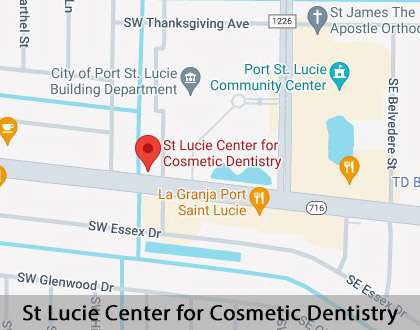Dental Bonding Port St. Lucie, FL
Dental bonding can help patients achieve a more seamless smile when teeth are not in their best condition. Dental bonding is when the dentist applies a tooth-colored resin material to any imperfections and then hardens it with a special light. This adheres the material to the tooth to restore a patient's smile. This procedure repairs chipped, cracked, or discolored teeth.
Dental bonding is a relatively simple treatment that does not typically require any anesthesia. Dental bonding is available at St Lucie Center for Cosmetic Dentistry in Port St. Lucie and the surrounding area. Call us at (772) 242-4124 to schedule an appointment or see whether this procedure is right for you.
Understanding Dental Bonding
Dental bonding is a cosmetic dental procedure that can repair tooth damage. The bonding process involves the adhesion of composite resin, a durable plastic material, to the tooth's surface. The tooth-colored resin ultimately bonds to the tooth to improve its overall appearance.
This procedure is helpful for people with chipped, cracked, decayed, or discolored teeth. The composite resin used in dental bonding is pliable, allowing our dentist to customize and mold it into the proper shape or size. Our dentist can also color match the composite resin to closely match it to the natural color of the patient's teeth.
“The bonding process involves the adhesion of composite resin, a durable plastic material, to the tooth’s surface.”
Candidates for Dental Bonding
Patients with aesthetic dental problems are the best candidates for dental bonding. Dental bonding is ideal for cosmetic dental issues that do not require major restorative work. Patients that are interested in receiving this treatment should have healthy teeth without excessive decay or trauma. Teeth should also have roots that are in good condition and most of their enamel intact.
Dental bonding can help fix various dental issues, including:
- Abnormally sized teeth
- Discolored teeth
- Exposed tooth roots caused by receding gums
- Minor cracks or chips
- Misshapen teeth
- Small gaps in teeth
“Dental bonding is ideal for cosmetic dental issues that do not require major restorative work.”
Dental Bonding Benefits
Dental bonding is a good option for restoring teeth since it is a minimally invasive procedure. This procedure allows patients to keep as much of the natural tooth structure as possible. During the application process, our dentist removes very little to no enamel at all. Minimal work to the enamel allows patients to maintain the natural health and structure of their teeth.
This quick treatment produces high-quality results that appear natural. The composite resin is durable but adaptable and can be adjusted by our doctor in the future after treatment. Dental bonding also protects and restores the function of worn-down, chipped, or discolored teeth.
“This quick treatment produces high-quality results that appear natural.”
Check out what others are saying about our dental services on Yelp: Dental Bonding in Port St. Lucie, FL
Process of Dental Bonding
The dental bonding process is quick and relatively non-invasive. Our dentist will select a composite resin color that matches the patient's tooth color before the dental bonding process. If a patient's tooth requires drilling to change its shape or damage near a nerve, our dentist may apply a local anesthetic to minimize discomfort. During the procedure, the tooth surface is roughened and given a conditioning liquid to help the bonding material adhere to the tooth.
Our dentist will then apply, mold, and smooth the resin into the desired shape before hardening the material with a light or laser. Once the resin hardens, it is trimmed, shaped, and polished to match the tooth's surface. The bonding process typically takes one appointment and lasts about 30 to 60 minutes for each tooth.
“The dental bonding process is quick and relatively noninvasive.”
Questions Answered on This Page
Q. Who is the right patient for dental bonding?
Q. What are the benefits of dental bonding?
Q. What happens during the dental bonding process?
Q. What are the differences between veneers and dental bonding?
People Also Ask
Q. How can cosmetic dentistry restore teeth?
Q. Why is it important to find the right general dentist?
Q. How can someone find out what procedures their dental insurance covers?
Q. What are the benefits of composite fillings?
Q. Where can I learn more about my dental diagnosis and treatment?
Dental Bonding vs. Veneers
Dental veneers are also a common dental restoration procedure. This thin porcelain material is specifically made to fit onto a tooth. Veneers are more invasive since they require the removal of the natural tooth structure.
Unlike dental bonding, a portion of the tooth will need to be removed so the veneer can fit tightly. It can also take several visits to make sure the fit is perfect. Both options are designed to blend with the color of surrounding teeth.
“Unlike dental bonding, a portion of the tooth will need to be removed so the veneer can fit tightly.”
Frequently Asked Questions
Q. Are there any risks with dental bonding?
A. There are no major risks associated with dental bonding. Keep in mind, a dental bond is not as strong as your natural tooth. Since it can chip or crack, it is a good idea to stop habits such as chewing on ice or biting your fingernails.
Q. How much does dental bonding cost?
A. Dental bonding is more cost-effective than many other restorative dental procedures. Costs vary depending on the location of the bond and the extent of the procedure. Check with your insurance provider to see if dental bonding gets covered under your policy.
Q. How long does dental bonding last?
A. With proper care, a dental bond can last for a decade. Touch-ups can be done if our dentist notices some wear and tear. Plan to take care of your bonded tooth just as you would the rest of your teeth.
Q. What kinds of conditions can dental bonding fix?
A. Dental bonding can address a variety of dental conditions. This includes chipped teeth, gaps between your teeth, fixing a tooth that is an odd shape, and even cosmetic fillings. Our staff can help you determine if dental bonding can correct your smile concerns.
Q. How does dental bonding work?
A. To begin, we create a composite resin material that matches the color of your teeth. The teeth are roughened to allow the resin to bond correctly. We will then apply the resin and use a special curing light to harden the resin, bonding it instantly to your teeth. Lastly, we can reshape and polish any areas as needed to ensure they look as natural as possible with the surrounding teeth.
Dental Terminology
Helpful Related Links
- American Dental Association (ADA). Glossary of Dental Clinical Terms. 2024
- American Academy of Cosmetic Dentistry® (AACD). Home Page. 2024
- WebMD. WebMD’s Oral Care Guide. 2024
About our business and website security
- St Lucie Center for Cosmetic Dentistry was established in 1984.
- We accept the following payment methods: American Express, Cash, Check, Discover, MasterCard, and Visa
- We serve patients from the following counties: St. Lucie County
- We serve patients from the following cities: Port St. Lucie, River Park, White City, Fort Pierce, Fort Pierce South, St Lucie West, Tradition, Palm City, Jensen Beach, and Stuart
- Norton Safe Web. View Details
- Trend Micro Site Safety Center. View Details
Back to top of Dental Bonding
















